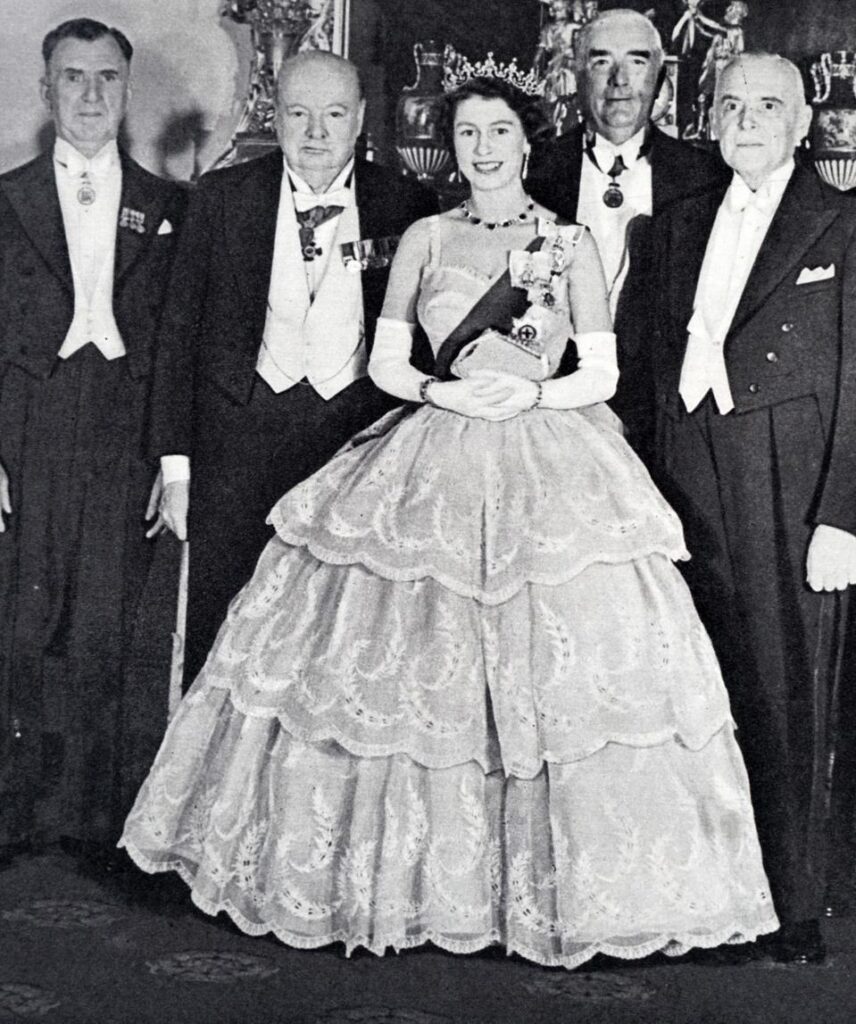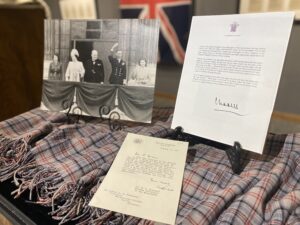
Finest Hour 199
The Queen, Australia, and Sir Winston Churchill

Queen Elizabeth II with Commonwealth prime ministers (L-R) Sir Sydney Holland of New Zealand, Churchill, Robert Menzies of Australia, and Louis St. Laurent of Canada
April 20, 2024
Finest Hour 199, Special Issue 2022
Page 27
By Harry Atkinson
“I have always looked forward to my visit to this country, but now there is the added satisfaction for me that I am able to meet my Australian people as their Queen….”—Queen Elizabeth II, 3 February 1954
HM The Queen had an intimate relationship with Australia that spanned an incredible seven decades. Her first Royal Tour of her largest realm in the southern hemisphere took place when Sir Winston Churchill still served as her first Prime Minister. As the Head of Government, Churchill had to consider such practical matters as the financial costs of the tour and the safety of the monarch.
The Royal Tour of Australia for then Princess Elizabeth and her husband the Duke of Edinburgh was originally planned for 1952. They had in fact begun the tour in February, which involved engagements in Africa on the way to Australia. In Kenya, however, the news came through that King George VI had died. The new Queen and her Prince Consort immediately returned to London, where they were greeted at the airport by Prime Minister Churchill.
Following the King’s death, Churchill put forward what he called a private project for the King’s widow, now the Queen Mother, to be appointed Governor General of Australia. He discussed the idea with his private secretary, John Colville, and reports indicated that the Queen Mother was keen on the idea. Churchill then consulted Australian Prime Minister Robert Menzies, who had the final say on the appointment. A meeting between the two premiers was scheduled for later that year, but the proposal never came to pass. Instead the great British General Sir William Slim received the appointment.
On the morning that the King’s death was announced, Churchill held a Cabinet meeting and indicated that the the Queen’s Coronation was likely to be held in the spring of 1953. Eventually the date was set for 2 June of that year. The governments of Australia and New Zealand were keen for the Queen to visit both countries after her coronation, so it was decided at the time to pencil in autumn 1953 for the postponed Royal Tour. This was eventually pushed back to late November, when the Royal Couple restarted the tour in Jamaica. They subsequently visited Fiji, Tonga, and New Zealand before arriving in Australia in February 1954, the hottest month of the year.

2024 International Churchill Conference
On 3 February, the Queen and the Duke of Edinburgh sailed into Sydney Harbour aboard SS Gothic; HMY Britannia was still some months away from commissioning. Her Majesty’s first steps on Australian territory were at Farm Cove, where Captain Arthur Philip RN, the first Governor of the New South Wales colony, raised the British flag 165 years before during the reign of King George III. The Queen’s arrival in Australia stopped the nation. Reports estimated one million people took to the streets of Sydney to welcome her. The entire population of Sydney at the time was 1,863,161.
Just prior to the Royal Couple’s visit to Western Australia, an epidemic of polio-myelitis began to unfold. Churchill was very concerned and thought it necessary that the British Cabinet consider urgently the health and safety of the Royals. The Queen’s principal medical adviser, Sir Horace Evans, believed that there was only a slight risk. He advised that this could be reduced further by taking sensible precautions, including secure food preparation and avoiding close contact with large crowds. Sir Horace informed the Cabinet that a second inoculation of gamma globulin could provide the Royal Couple with some immunity for the few weeks they would be in Australia.
Churchill considered two main questions. First, what was the level of risk to the Queen’s health? Second, should the visit to Western Australia go ahead as planned, or should it be cancelled? The Prime Minister’s perspective was that the Queen would feel reassured by the knowledge that her government had carefully considered the situation and that advice was provided to her.
Others viewed the situation as overstated. The risk that the Queen might catch polio-myelitis was incredibly small. Notably, there had been a lack of precautions put in place for the Royal Family when an epidemic of polio-myelitis broke out in the United Kingdom in 1947 and again in 1951. Further, the risk was significantly higher for the Queen to be involved in a plane crash during the tour, especially in the 1950s.
Churchill faced a delicate political matter. Constitutionally the Queen had to take advice from her Australian ministers whilst in Australia. Churchill, however, felt justified in sending a private telegram to the governor of Western Australia asking for more information to be provided about the epidemic and guarantees of the Royal Couple’s safety. He also sent the same telegram to the British High Commissioner in Canberra but made clear that he did not wish to consult with Australian Prime Minister Robert Menzies at that time. Further Cabinet meetings ensued. The Cabinet realised that, even though no precautions had been taken in 1947 or 1951, the fact remained that the Royal Couple were on a high-profile tour with significant media coverage. The decision was made that it was important to discuss the matter more closely with Menzies and the wider Australian government.
Menzies took heed of Churchill’s concern and insisted that the Royal Couple sleep on SS Gothic and eat only food prepared on the ship during the Western Australian segment of the tour. Despite this drama, the Royal Tour in Western Australia was a great success. The Queen and the Duke were able to visit not only Perth, but also a number of towns dotted across the state, including Kalgoorlie, Busselton, and Albany.
The first Royal Tour of Australia was an exceptionally busy and well-choreographed event. The Royals visited seventy towns and cities across the island continent during their fifty-eight days in Australia. Conducting an average of five engagements a day, they traversed the harsh and arid landscape by ship, plane, train, and automobile from Cairns in the far north of Queensland to Hobart in the south of Tasmania, as well as travelling to Perth in the far west. They had covered more than 10,000 miles by air and 2,000 miles on the ground by the time they left Australia on 1 April. It was a magnificent tour. The Queen subsequently visited Australia another fifteen times during her reign, each visit just as special as the last.
May she rest in peace.
Subscribe
WANT MORE?
Get the Churchill Bulletin delivered to your inbox once a month.




